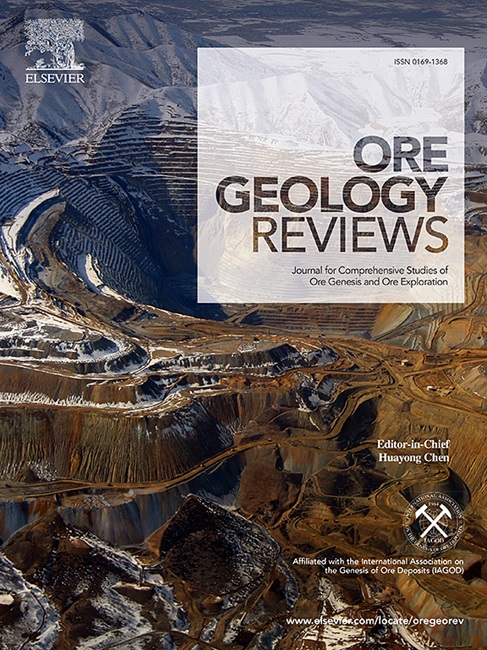新疆西北部比加半岛特提斯成矿带白云岩型钍铀三稀土矿化性质及成因
IF 3.6
2区 地球科学
Q1 GEOLOGY
引用次数: 0
摘要
本文章由计算机程序翻译,如有差异,请以英文原文为准。

Nature and origin of dolomite-hosted Th-U-HREE mineralization in the Tethyan Metallogenic Belt, Biga Peninsula, Northwestern Türkiye
The Biga Peninsula in northwestern Türkiye, a metallogenic province in the Tethyan Metallogenic Belt, hosts economically significant gold-copper deposits and thorium-uranium-rare earth elements (Th-U-REE) occurrences, including both light REE (LREE) and heavy REE (HREE) styles of mineralization. This contribution focuses on the nature and origins of Th-U-REE mineralization in the Arıklı district, Biga Peninsula, where three zones of Th-U-REE mineralization (A, B, and C) each extends only a few meters along faults in Cenozoic volcanic rocks. Zones A and C of U-Th-LREE mineralization are hosted by fluorapatite-sulfide-hematite and dolomite-fluorapatite assemblages and have U-Th-REE concentrations up to 1,152 ppm and 2,221 ppm, respectively, with fluorapatite as the principal U-Th-REE-bearing mineral. In contrast, Zone B of Th-U-HREE mineralization is hosted by a dolomite-dominant assemblage, with Th, U, and total HREE + Y concentrations up to 25,600 ppm, 4,100 ppm, and 3,535 ppm, respectively, with cheralite (CaTh(PO4)2) as the principal ore mineral. Four stages of dolomite have been identified in the main mineralization Zone B: fine to medium-crystalline dolomite (D1; anhedral), pervasive medium-grained dolomite (D2; subhedral to anhedral), dolomite rhombs (D3), and void-/vein-filling coarse-crystalline dolomite (D4). Two stages of void-/vein-filling cheralite coincide with dolomite D3 and D4. The first stage cheralite shows intense hydrothermal modification, resulting in a disturbed U-Th-Pb isotopic system. Secondary cheralite of minimal hydrothermal disturbance yielded 206Pb-238U age of 18.8 ± 1.6 Ma (2σ, MSWD = 1.3) and 208Pb-232Th age of 18.15 ± 0.08 Ma (2σ, MSWD = 2.3). Carbon and oxygen isotope compositions differ significantly from those of primary igneous carbonatites but are close to sedimentary rocks, indicating that all dolomites have a hydrothermal origin with sedimentary sources. These results collectively suggest that Early Miocene hydrothermal fluids most likely originated from mantle-derived alkaline magmatism and interacted with carbonate sedimentary rocks, facilitating the mobilization, enrichment, and precipitation of dolomite-hosted Th, U, and HREE mineralization in fault zones.
求助全文
通过发布文献求助,成功后即可免费获取论文全文。
去求助
来源期刊

Ore Geology Reviews
地学-地质学
CiteScore
6.50
自引率
27.30%
发文量
546
审稿时长
22.9 weeks
期刊介绍:
Ore Geology Reviews aims to familiarize all earth scientists with recent advances in a number of interconnected disciplines related to the study of, and search for, ore deposits. The reviews range from brief to longer contributions, but the journal preferentially publishes manuscripts that fill the niche between the commonly shorter journal articles and the comprehensive book coverages, and thus has a special appeal to many authors and readers.
 求助内容:
求助内容: 应助结果提醒方式:
应助结果提醒方式:


